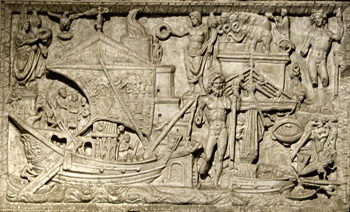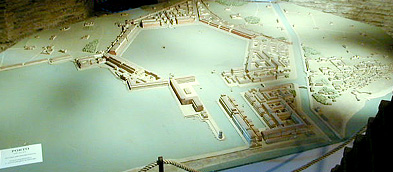
portus

The word portus, meaning "harbor,
port,"
was used for the quays that began to be constructed in the 2nd century BCE
along the banks of the
Tiber
River in Rome, to accommodate merchant and military ships (see
Museum
of Roman Ships) and
warehouses and granaries. It also signified Rome's harbor at the mouth of
the Tiber, which was almost silted over by the mid-1st century BCE (see
Ostia:
Harbour City), as well as the
harbor town,
itself called Portus, both of which were connected to Rome by the
via
ostiensis.
Portus was originally
conceived by Julius Caesar and built 2 miles north of Ostia (see
map)
at the branch of the Tiber called the Fiumicino by Claudius (see
harbor plan and the
coin of
Nero, struck to mark the opening of the new harbor at Ostia, 58-64 CE). In
response to the dangers of the exposed moles of Claudius' harbor and increased
shipping, in the early 2nd century CE the harbor at Portus was
enlarged and given a
protected
hexagonal
inner basin by Trajan (see a reference to this harbor in Juvenal,
Satura 12.75-82). A
reconstruction of Portus
(see plan of the double
harbor) was painted in 1970, based on a late 16th century fresco landscape
showing the
ruined
monuments of the town.
In using the plural form, Umbricius' statement
embraces all of the above, as no doubt harbor and riverside construction and
repair were a constant feature of Roman public works.
